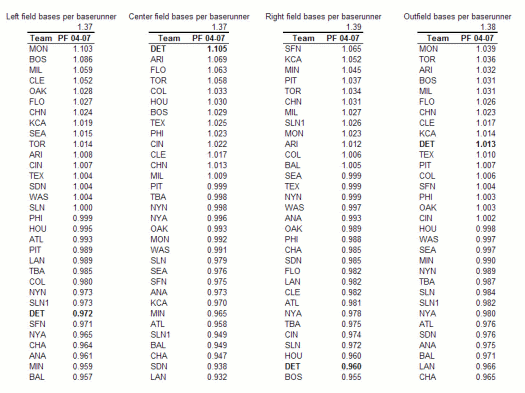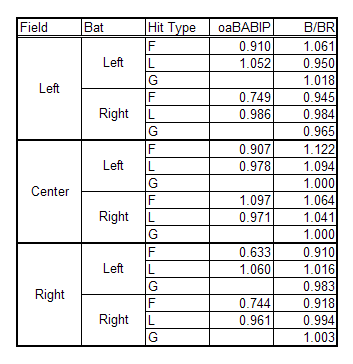Earlier in the week, I questioned the widely held belief of whether with an outfield like Comerica Park’s the Tigers should have 2 centerfielder-types to man the large left and center fields. Using park factors and looking at the rate at which balls in the air drop in for hits, we saw that fewer balls drop in in left and center at Comerica Park, while more tend to fall in right field. Now we’ll take a look at what happens when the balls do drop in.
Again I will turn to park factors. And again I will borrow from Dan Fox and use a metric that is total bases per baserunner. And like the previous analysis, I focused on balls in the air.
The tables below represent the park factors for each of the areas of the outfield, as well as an overall rate. (click the chart for a larger image)

Here’s where the Comerica Park we know and love comes out. There is more extra base goodness in Comerica Park’s center field than any other stadium, and not surprisingly it comes in the form of triples. Over the last 4 years 8.7% of all triples hit to center field in the Majors have come in Detroit. Here is the distribution of hit type on balls fielded by the center fielder:
1B 2B 3B
MLB 68% 28% 5%
DET 63% 25% 13%
If the ball gets to the wall, only the slowest of the slow runners aren’t going to end up with a triple. While it’s not surprising to see doubles turned into triples, it is a little surprising to see so many singles turned into triples. It must be a function of the fact that centerfielders play relatively shallow cutting off many would be singles which does correspond with the earlier data where fewer balls drop into center field at Comerica.
But back to the original question about the difficulty of playing left field in Detroit, the data just doesn’t bare that out. Fewer balls drop for hits, and there are fewer bases per baserunner in left field. In right field we see a few more balls dropping for hits, but it is one of the toughest fields to get extra bases. Perhaps the right fielders are playing too deep?
While having multiple outfielders with above average speed and range is never a bad thing – especially in larger parks of which Comerica Park definitely ranks – there isn’t anything about Comerica’s left field that makes it any more necessary than in any other stadium. While the argument for “2 centerfielders” can certainly be made, it really only looks like it would help if they were both manning center at the same time.
The information used here was obtained free of charge from and is copyrighted by Retrosheet. Interested parties may contact Retrosheet at www.retrosheet.org

